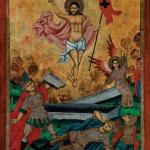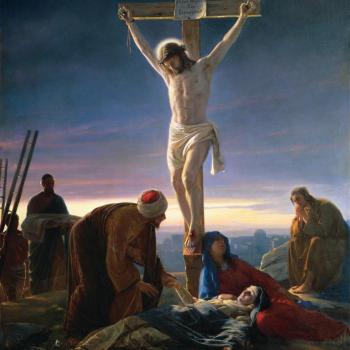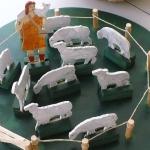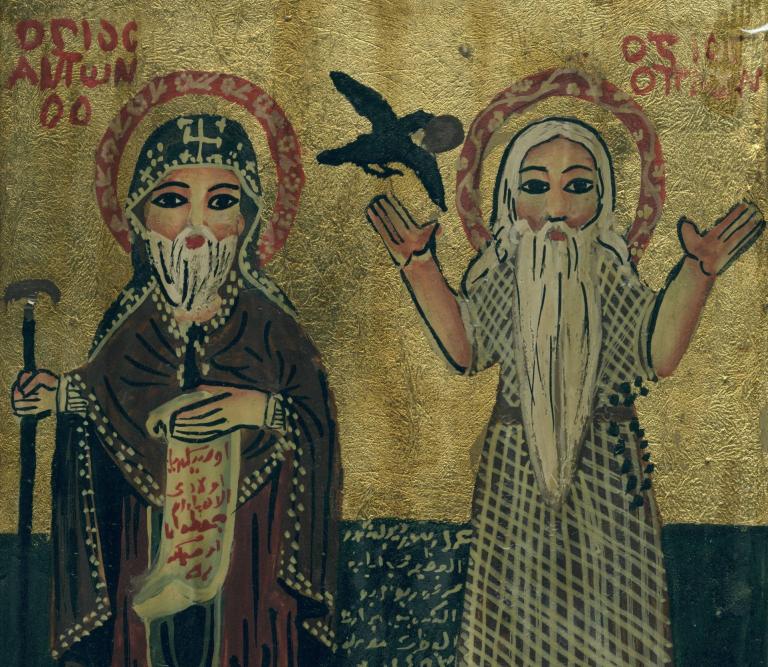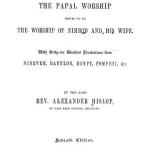The Resurrection is a work of God the Blessed Trinity. All three Persons of the Godhead are involved and, as in all things, all three Persons operate in perfect harmony to accomplish it. The Father “raised up” Christ his Son (Acts 2:24, 32). The Son declares, “I lay down my life, that I may take it again. No one takes it from me, but I lay it down of my own accord. I have power to lay it down, and I have power to take it again; this charge I have received from my Father.” (John 10:17-18). And that miracle of Resurrection is how Jesus is conclusively revealed as “Son of God in power according to the Spirit of holiness” (Romans 1:4).
Because the Resurrection is the work of exactly the same God of Israel who revealed himself to Abraham, Moses, and the prophets in the Old Testament, the early Church understands Jesus as standing in continuity with, not contradiction of all that God has revealed in the Old Testament. Jesus himself had insisted on this, teaching his disciples, “Do not think that I have come to abolish the law and the prophets; I have come not to abolish them but to fulfil them” (Matthew 5:17). And so one of the curious details of the Resurrection story is the insistence of the eyewitnesses that Jesus was not merely raised from the dead, but raised on the third day in accordance with the scriptures. Jesus, after all, could have been raised at any time after death was ascertained. One hour, six hours, one day later would have been just as much a miracle. But all the witnesses insist that Jesus was buried and remained in the tomb for three days (recalling that a day was reckoned to begin, not end, at sunset in his culture). He was buried on Friday afternoon, but not raised till Sunday. And they insist that this Resurrection on the third day means that Jesus is therefore in continuity with and fulfillment of everything God has done in the history of Israel and the revelation he has given to and through the Jewish people.
So it is worth asking, “Why the third day?”
However, to get at the answer to that, we must first ask what a biblical author means when he says something “fulfils” or “is in accordance with” the Scriptures.
Reading the Bible as the First Christians Did
It is easy for the modern reader to adopt a kind of “prediction” view of Old Testament prophecy, as though every first century Jew had an agreed-upon set of “Old Testament Messianic Verses” against which all messianic claimants were measured. Indeed, many Christian apologetics books today lay out precisely this sort of checklist:
| Prophecy: | Source: | Fulfillment: |
| Messiah must be: | OT | NT |
| born in Bethlehem | Micah 5:1-2 | Matthew 2:1 |
| adored by the great | Psalm 72:10-11 | Matthew 2:1-11 |
| sold for 30 silver pieces | Zechariah 11:12 | Matthew 26:15 |
One could easily get the impression that all a first century Jew had to do was follow Jesus around and tick off prophecy fulfillments on his Old Testament Messianic Prediction Checklist and he ought to have known everything Jesus was going to do before he ever did it.
But, in fact, as Augustine once observed, the Bible’s messianic prophecies were not so much revealed by the Old Testament as they were hidden there.[1] This isn’t a notion cooked up in the Dark Ages to justify reading into the Old Testament whatever Christians wanted to see there. It’s a truth taught to the apostles themselves by the risen Christ:
Then he said to them, “These are my words which I spoke to you, while I was still with you, that everything written about me in the law of Moses and the prophets and the psalms must be fulfilled.” Then he opened their minds to understand the scriptures, and said to them, “Thus it is written, that the Christ should suffer and on the third day rise from the dead, and that repentance and forgiveness of sins should be preached in his name to all nations, beginning from Jerusalem.” (Luke 24:44–47)
It is from Jesus, then, that the apostles get the idea that the whole life and ministry of Christ fulfilled the Scriptures. But Jesus fulfills them not by ticking off items on a Messianic Prediction Checklist but by revealing the gospel that was hidden in the law and the prophets.
This is why Paul says the New Covenant was “veiled” until the gospel took away the veil (cf. 2 Corinthians 3:14). It is also why he declares that the gospel was “not made known to the sons of men in other generations as it has now been revealed to his holy apostles and prophets by the Spirit” (Ephesians 3:5; emphasis added). Paul insists the deepest meaning of the Old Testament was seen only in light of the Life, Death, and Resurrection of Christ.
Because the New Covenant is hidden, not revealed, in the Old Testament, nobody before the time of Jesus says, “Why, it’s plain from Scripture the Messiah will be born of a virgin, raised in Nazareth, rejected by the chief priests, handed over to Gentiles, crucified with thieves, rise from the dead, ascend into heaven, and abrogate the circumcision demand for Gentiles converts to the covenant people as he breaks down the barriers between man and woman, slave and free, Jew and Gentile.” Even the disciples themselves, close as they were to Jesus, didn’t anticipate the Crucifixion, much less the Resurrection—even when Jesus rubbed their noses in messianic prophecy and spelled out what was coming (cf. Mark 9:9-10). As John says, they did not understand from Scripture that the Messiah had to rise from the dead, even while they were standing in the very mouth of Jesus’ empty tomb, gawking at his grave clothes (cf. John 20:1-10). And yet, these same apostles later speak of the Resurrection as a fulfillment of Old Testament prophecy. What do they mean if the Old Testament prophecies aren’t predictions upon which everybody based their understanding of Messiah?
What Fulfilment Means
They mean Christ brought to fruition, and was the ultimate expression of the same revelation toward which all the Old Testament was straining and pointing. They mean Jesus was the One to whom the law and the prophets were directed by the Holy Spirit, even when the sacred writers themselves did not know the fullness toward which their words pointed (cf. 1 Pet. 1:10-11).
This is why the early Church was never troubled by an issue that often vexes modern minds: namely, why the New Testament often appears to take Old Testament texts out of their immediate context and read them as commentaries on Christ. For the early Church doesn’t see the Old Testament as talking about something different from Christ, but rather sees it in relationship to him. What appear to the modern mind as separate themes and events in the Old Testament appear to the New Testament writers as so many spokes on a wheel, all connected to the Hub who is Christ. They believe that just as we write with words, so God writes with people, things, historic events, and occurrences, both natural and supernatural.
For instance, Hebrews 2:13 applies Isaiah 8:18 to Christ: “Here I am, and the children God has given me.” In its original context, Isaiah is speaking about himself and his disciples. He’s not offering a prediction that the coming Messiah would say this. Yet the author of Hebrews sees Christ, far more than Isaiah, fulfilling the text. Why? Because Christ and his Church are, most fully, what Isaiah and his disciples were in a kind of foreshadow. Isaiah’s words, like all words, are signs signifying something: in this case Isaiah and his own disciples. But Isaiah and his disciples are, in their turn, also signs signifying something even greater: Christ and his disciples. For Christ and his Church are the same thing Isaiah and his disciples were: “signs and portents in Israel from the Lord of hosts, who dwells on Mount Zion” (Is. 8:18). Isaiah and his disciples fulfill the passage in an immediate sense. But the early Church saw no particular reason why the God Isaiah worshipped couldn’t fulfill it even more profoundly when he became incarnate and established his Church. So the author of Hebrews, reading the Isaian passage with hindsight illumined by Jesus’ entire life and ministry, hears the Composer of the Symphony of Divine Revelation play a theme through Isaiah and his disciples in a minor key which he will ultimately play in a major key in Christ.
The Virgin Birth as a Case Study in Fulfilment of Scripture
The same thing applies to Isaiah 7:14, the passage Matthew quotes with regard to Jesus’ Virgin Birth. Matthew knew his Bible extremely well and was perfectly aware that this passage had an immediate fulfillment in Isaiah’s day. Isaiah’s Emmanuel Prophecy comes in an hour of national crisis during the reign of Ahaz, one of the lousier kings of Judah descended from David. In Isaiah’s day, the people of Israel had actually been split into two realms: a northern kingdom called “Israel” which had broken away from the House of David, and a southern kingdom called “Judah” which remained loyal to the Davidic dynasty and its successor, Ahaz.
At the time of the Emmanuel Prophecy (roughly seven centuries before Christ), Israel has formed an alliance with pagan Aram against Ahaz’ kingdom of Judah. As a result the people of Judah are in a muck sweat about the future of their country. So Isaiah goes to Ahaz and tells him not to worry about the alliance because God will take care of Judah, for the sake of his promises to David. To back up his assurances, Isaiah offers Ahaz the chance to “ask a sign of the Lord your God” (Is. 7:11). Ahaz refuses. He pretends he’s too pious to put God to the test, but actually he does not want to obey Isaiah because he’d rather put his faith in practical politics and not in Isaiah’s mystical hocus-pocus.
It is then that the Emmanuel Prophecy is given: “Behold, an almah [a word that can be rendered either as young woman or as virgin] shall conceive and bear [or is with child and shall bear] a son, and shall call his name Immanu-el” [which, as Matthew will later note, means God with us]. What does Isaiah mean?
Most immediately, Isaiah means Ahaz will have a son—Hezekiah—who will carry on the line of David so that, as Nathan had long ago prophesied to David, “your throne shall be established forever” (2 Sam. 7:16).[2] In other words, Isaiah is telling Ahaz that “God is with” the Davidic throne of Judah still and his kingdom will therefore not be defeated by the menacing alliance to the north.
And that’s exactly what happened. The alliance against Judah fails and Hezekiah is born. The prophecy’s most immediate sense is indeed fulfilled, not by a virgin birth, but by the almah or wife of Ahaz and the birth of a new “son of David” to carry on the Davidic line.
But there remains in pre-Christian Jewish tradition a persistent belief in larger and second meanings in its Bible. For the question remains, “Why was the son of David called ‘Hezekiah’ born if not for a still greater Son of David who is yet to come?” For, of course, Hezekiah will eventually die too.
So as the centuries roll on there is a growing sense among the Jews that Nathan’s prophecy to David of an everlasting throne recorded in 2 Samuel 7 (despite these immediate fulfillments) speaks not so much of an everlasting political rule, but of some higher and greater Throne yet to come. And so, when the political power of David’s house actually does fail during the Babylonian Captivity in the fifth century B.C.E, Israel reflects on Nathan’s words and wonders what deeper meaning might be in them. Indeed, Isaiah himself tells Israel that from the “stump of Jesse” (that is, the fallen Davidic dynasty) a “shoot” shall grow. Of this coming king, this “Son of David,” this Anointed One or Messiah Isaiah prophesies:
And the Spirit of the Lord shall rest upon him, the spirit of wisdom and understanding, the spirit of counsel and might, the spirit of knowledge and the fear of the Lord. And his delight shall be in the fear of the Lord (Isaiah 11:2–3).
In other words, Isaiah is aware the story does not end with the birth of Hezekiah. The Lord saves Ahaz’ throne, not for Ahaz’ sake, nor for Hezekiah’s, but for the sake of the promise given long ago to David that will only be finally fulfilled when the ultimate Son of David is born, the Son of whom Isaiah also spoke:
For to us a child is born, to us a son is given; and the government will be upon his shoulder, and his name will be called “Wonderful Counselor, Mighty God, Everlasting Father, Prince of Peace.” Of the increase of his government and of peace there will be no end, upon the throne of David, and over his kingdom, to establish it, and to uphold it with justice and with righteousness from this time forth and for evermore (Isaiah 9:6–7).
So the birth of a son of David named Hezekiah both fulfills the prophecy of Isaiah 7:14 and foreshadows an even greater fulfillment in the birth of the ultimate Son of David, Jesus, who is born, not merely of a young woman, as Hezekiah was, but of a virgin.
Some people imagine that Matthew is responsible for translating almah as ‘virgin’ instead of ‘young woman’ in order to make Isaiah predict the Virgin Birth. But, in fact, it was the Septuagint’s Jewish translators who rendered it into Greek as parthenos or virgin two centuries before Matthew was born. Recall that the translation was made quite a bit before the sexual revolution in the 1960s. Hence, it was commonly assumed in the culture of the translators that a newly married young woman would naturally be a virgin. Faced with a choice between the Greek word for “young woman” and the Greek word for “virgin” they opted, in the Providence of God, to use the latter.
Other people assume that Matthew, reading a “bad” translation mistakenly assumed Jesus was born of a virgin because the Greek version of Isaiah told him so. But, of course, Matthew knows Hebrew as well as Greek and is perfectly well aware of what the original text of Isaiah said. He did not derive his belief in Mary’s virginity from Isaiah 7:14. He didn’t sit down one day, read the Septuagint version of Isaiah, and say to himself, “Let’s see. Isaiah says something about a virgin here. So if I’m going to cook up a Christ figure, I’d better make him the son of a virgin so it will fit with this text.”
On the contrary, the only reason the apostles are telling stories about Jesus at all is not because they saw Jesus’ birth, but because they saw the risen Jesus. It was this that got their attention and prompted them to inquire about his origins. And they inquired about Jesus’ origins, not from Isaiah, but from the only person who could possibly have told them the story: Mary.
It is only after they have heard Jesus tell them the Law and the prophets are, ultimately, about him, and only after they’ve heard the story of Jesus’ birth from Mary that they look at their Septuagint Bibles, find Isaiah’s prophecy and see Jesus reflected in it. Because the point of the Emmanuel Prophecy is, they now realize with a jolt, completely fulfilled. God has, in the utmost and ultimate sense, revealed that he is “with us” not merely by ensuring the birth of one more mortal Davidic king named Hezekiah, but by taking flesh from the Davidic line himself, sharing our humanity even unto death and rising to eternal life. Hezekiah’s birth showed that God was still with the House of David. The birth of Jesus shows why he was with the House of David: to prepare the way for the Messiah who
will be great, and will be called the Son of the Most High;
and the Lord God will give to him the throne of his father David,
and he will reign over the house of Jacob for ever;
and of his kingdom there will be no end.” (Luke 1:32-33)
Immediate and Long-Term Fulfilment
This idea of immediate and long-term fulfilment of prophecy is found throughout Scripture and the New Testament writers simply assume that we know this. For instance, Moses tells Israel to await a prophet like him (cf. Deuteronomy 18:15) and indeed many prophets like Moses appear. That’s why we have the books of Isaiah, Jeremiah, Ezekiel and the rest. Yet instead of seeing them as the final fulfillment of Moses’ promise, Israel instead believes some ultimate prophet is also coming; an Anointed One, Servant, Prophet, Son of David, or Son of Man (these titles are all used in the Old Testament), a man who will “utter what has been hidden since the foundation of the world” (Matt. 13:35), a man of whom all the Old Testament prophets—including Moses—are dim foreshadows. This is why the Jews asked John the Baptist if he was “the Prophet” (John 1:21; emphasis added).
Messianic Prophecy: Hidden and Clear
Understanding of the Old Testament’s messianic message was characterized by clarity and obscurity in the time of Christ. Certain texts (like Nathan’s prophecy of an everlasting Davidic throne) were clearly understood by most first century Jews to be messianic. But other passages were overlooked entirely until Jesus’ astounding life put them into proper context. Nobody knew beforehand that Psalms 69 and 109[3] prophesied the election of Matthias to the apostolic office forfeited by Judas. Nobody anticipated the Passover lamb’s unbroken bones as a prophetic image of Christ’s unbroken bones (cf. John 19:31–36, Exodus 12:46 and Numbers 9:12). Nobody saw in advance that Isaiah 53 bears witness to the Crucifixion and Resurrection. If they had, says Paul, they would never have crucified the Lord of Glory (1 Corinthians 2:8). All these things are only seen after the fact to be eerily prophetic of Christ and his Church. They fill out the rough picture sketched by the more widely-acknowledged messianic prophecies, but only after Jesus’ life has provided the key to understand them.
The early Christians were very well aware of this immediate/remote, hidden/clear character of the Hebrew Bible. So they never mistook the Old Testament for a handy-dandy Rolodex filled with prediction proof texts and neatly organized by category to form the basis of Jesus’ ministry. The early Christians saw the Old Testament bearing inspired witness to the extraordinary man who had dwelt among them only after the fact.
So they did not, for instance, read “Zeal for thy house will consume me” in Psalm 69 and then decide “Let’s make up a story about Jesus cleansing the Temple based on this verse.” On the contrary, to their great surprise, Jesus cleanses the temple (John 2:13–16) and then his disciples remember the psalm and are struck by how it fits the event (cf. John 2:17).
This happens again and again in the New Testament. The disciples are as surprised as anybody else when Jesus heals the sick or raises the dead. They don’t foresee Christ’s miracles by reading the Old Testament. Rather, the ministry of Christ happens to them like a bolt from the blue and they then see an uncanny connection between what Jesus does and the weird way that it fits the Old Testament. When Jesus is sold for thirty pieces of silver or his hands and feet are pierced on the cross, the apostles do not foresee this by sticking their noses into Zechariah 11:12–13[4] or Psalm 22:16.[5] Rather, after Jesus is raised, they remember these things were written and, blinking their eyes in amazement, exclaim, “It was staring us in the face all along and we didn’t see it!” The Old Testament is not the basis of their belief in these things; it’s the witness to the truth of what they’ve already seen.
The Spiritual Sense of Scripture
There are even more interesting things to note about this profoundly biblical way of reading Scripture. The first is that Matthew, like all the New Testament authors and even Jesus himself, sees more than one “sense” at work in Scripture. That is, they take seriously the literal sense of the Old Testament, but they also take that literal sense for granted and see behind it a deeper meaning. They believe the stories reported there as fact are true, but they also believe these things “were written down for our instruction, upon whom the end of the ages has come” (1 Corinthians 10:11). So they read (and teach their disciples to read) the Old Testament as packed with all sorts of secondary meanings pointing to Jesus and his Church.
That’s why Jesus, taking for granted the literal sense of Exodus 16’s story of the manna in the wilderness, also tells us the manna is an image of himself, the Bread of Life (John 6:31–35). It’s why Paul, likewise taking for granted Israel’s passage through the Red Sea as historical, also sees it as an image of Baptism (1 Corinthians 10:1–2). It’s why John the Baptist sees the Passover lamb as a foreshadow of Jesus (John 1:29). Again and again, the New Testament reads the Old Testament this way. Given this, let us then return to the mysterious apostolic insistence that Resurrection on the Third Day is “in accordance with the Scriptures”.
[1] Cf. St. Augustine, Quaest. in Hept. 2, 73: PL 34,623; Cf. DV 16
[2] For a good argument that Isaiah’s prophecy is immediately fulfilled by the birth of Hezekiah, see Rev. William G. Most, “The Problem of Isaiah 7:14,” Faith and Reason, Summer 1992. Link available as of August 5, 2015.
[3] The Septuagint renderings of Psalm 69:25 (“Let his habitation become desolate,/and let there be no one to live in it.”) and Psalm 109:8 (“His office let another take.”) are cited by St. Peter in Acts 1:20.
[4] “Then I said to them, ‘If it seems right to you, give me my wages; but if not, keep them.’ And they weighed out as my wages thirty shekels of silver. Then the Lord said to me, ‘Cast it into the treasury’—the lordly price at which I was paid off by them. So I took the thirty shekels of silver and cast them into the treasury in the house of the Lord.”
[5] “Yes, dogs are round about me;/a company of evildoers encircle me;/they have pierced my hands and feet.”

